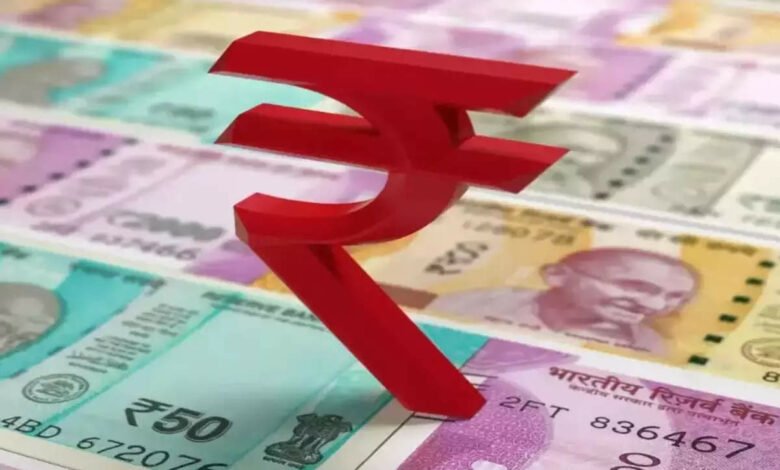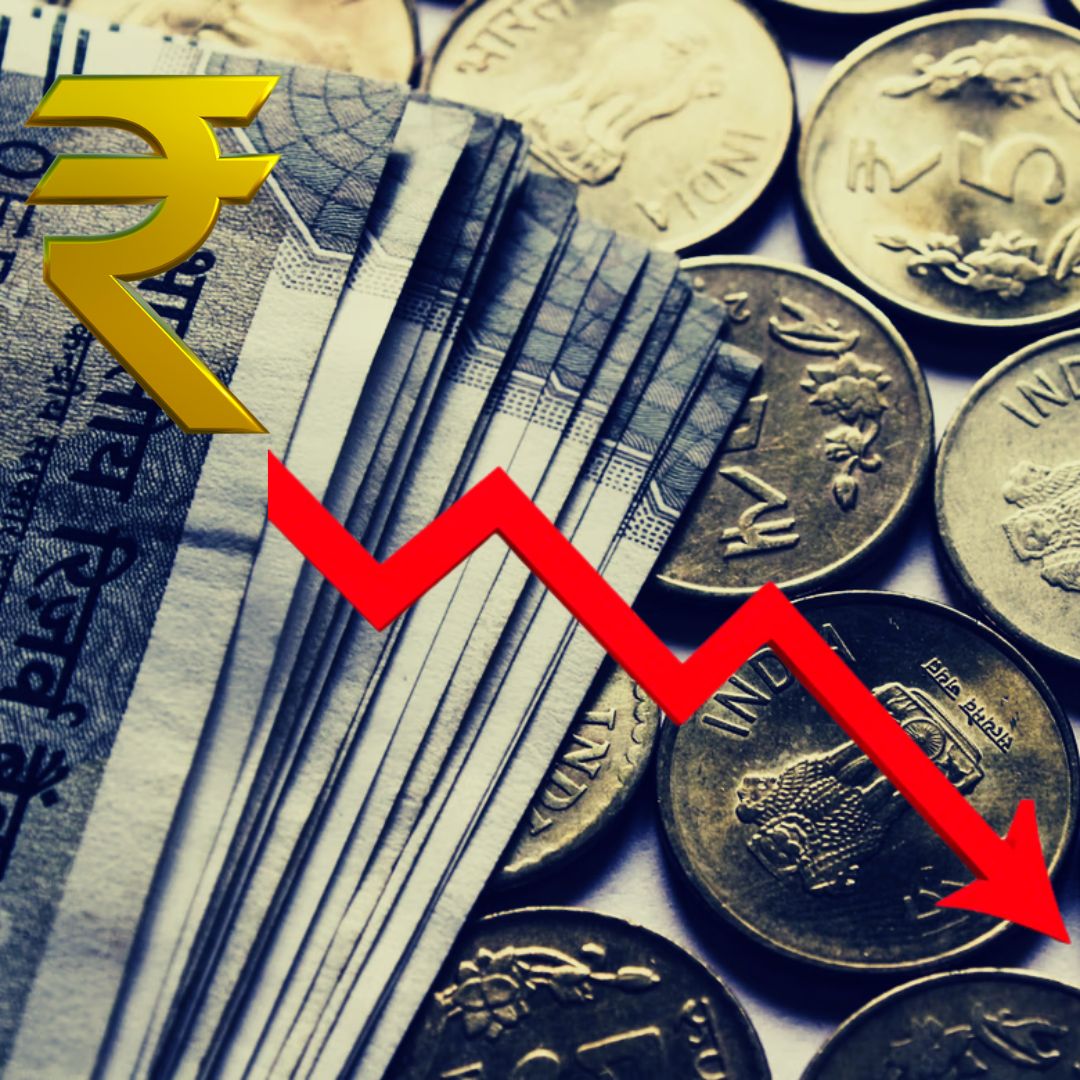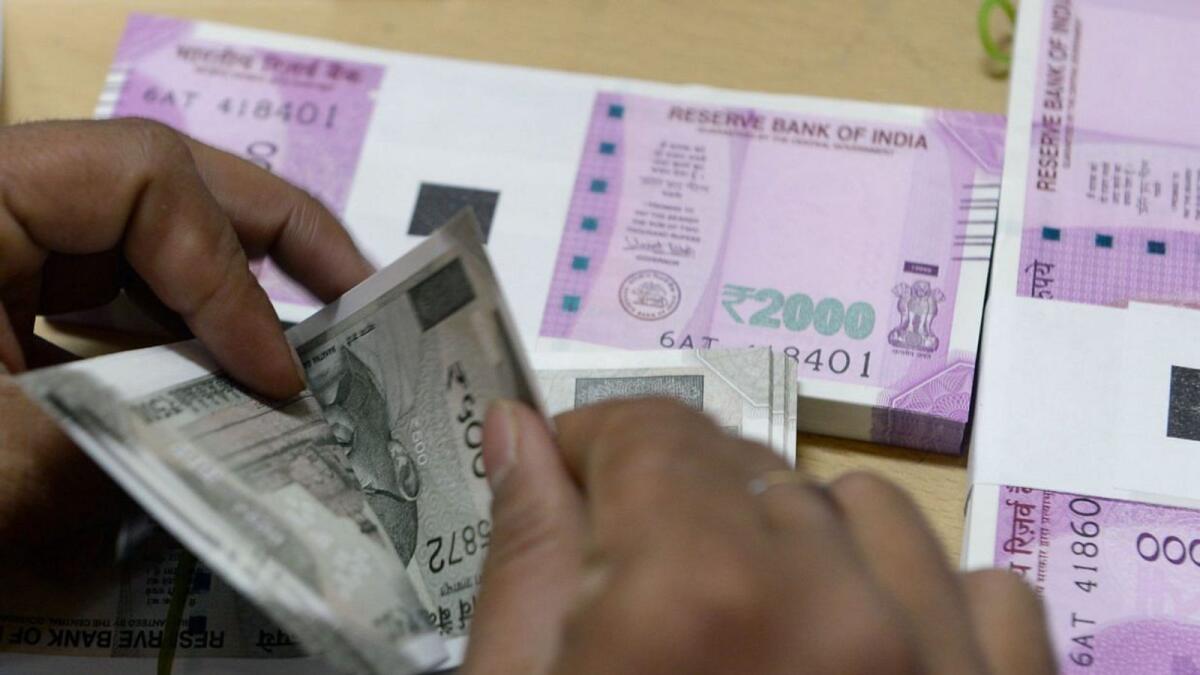The Indian rupee has reached an all-time low of Rs 77.41 vs. the US dollar.

The Indian rupee has reached an all-time low vs. the US dollar.
The reason for the rupee’s depreciation probably be attributed to demand for riskier Assets and in addition international investors continuing to sell domestic stocks.
Further currency depreciation is expected because local equities markets tumble and the global economy continues to weaken.
In early trade on Monday, India’s official currency, the Rupee, fell 51 paise to an all-time low of Rs 77.41 vs. the US dollar.
The rupee began at 77.17against the dollar on the interbank Foreign Exchange, before losing momentum to quote at 77.42, a 52-paise drop from the last close. The Rupee has already surpassed the last low of 76.98 set in March.
The rupee fell 55 paise to settle at 76.90 vs. the US dollar on Friday.
On Monday, the rupee fell to a new lifetime low against the US dollar because investors sold Indian equities and other Assets being part of a global trend away from risky emerging market Assets and into the safe-haven US currency.
During the day, the Indian rupee fell to Rs 77.52 per dollar. The rupee strengthened marginally to settle at Rs 77.46, although it remained below its Friday high of Rs 76.92 against the dollar.
The reason for the rupee’s depreciation probably be attributed to demand for riskier Assets and international investors continuing to sell domestic stocks.
Investors are concerned that the larger Asian stock market will continue to fall because the COVID lockdown in Shanghai tightens, threatening global economic development.
According to Sriram Iyer, Senior Research Analyst at Reliance Securities, the Indian Rupee began lower vs. the dollar on Monday because global shares fell on concerns about the economy and rising bond rates impacted on emotions.
Risk appetite has diminished, according to forex traders, because inflation fears grow, perhaps prompting more aggressive rate rises by global central banks.
The dollar index, which measures the strength of the greenback against a basket of six currencies, was up 0.35 percent at 104.02, after increasing US yields and concerns about higher interest rates.
Furthermore, Asian and developing market rivals started the day sluggish, weighing on emotions.
On the domestic equities market, the 30-share Sensex was down 737 points, or 1.34 percent, at 54,098.58, while the wider NSE Nifty was down 220.25 points, or 1.34 percent, at 16,191.00.
Brent crude prices increased 0.14 percent to USD 112.55 per barrel, the global benchmark.

According to Stock Exchange statistics, foreign institutional investors were net sellers in the capital market on Friday, offloading shares worth Rs 5,517.08 crore.
Last week’s surprise hike in the Indian central bank’s benchmark interest Rate seems to have done nothing to arrest the currency’s decline, according to Analysts.
A weakening rupee entails greater import expenses, from food to petrol, and more expensive international trips for consumers. For manufacturers, this entails higher component part pricing, among other things. All of these factors contribute to India’s rising inflation.
“A worsening in equities market sentiment being a result of a quick tightening in domestic financial conditions poses an important downside risk to the INR,” according to BNP Bank Paribas. The Indian central bank was said to be ready to intervene to stop the rupee from falling further due to speculation.
Because of rising US interest rates and growing US Treasury yields, the US dollar has been steadily climbing across the board.
The crucial 30-share Sensex continued to fall on Monday, feeding the rupee’s decline amid a selloff in global markets. After dropping by almost 900 points in intraday trade, the Sensex plummeted 0.67 percent, or 364.91, to settle at 54,470.67.
Reliance Industries dragged the index down as its shares fell almost 4% following a poor sequential earnings loss. Global stock markets are hurting from rising fears of interest rate hikes to combat rising inflation.
LIC: Foreign investors stay away
Meanwhile, international investors have mainly avoided the state-run Life Insurance Corporation of India’s $2.7 billion initial public offering, which concludes Monday. Domestic investors have snapped up India’s biggest ever IPO, which was priced significantly cheaper than expected as the situation in Ukraine rattled global financial markets.
Last week’s half-point interest rate boost by the US Federal Reserve, which pushed markets down, caused the rupee’s current round of weakening. Since the beginning of the year, foreign institutional investors have sold Indian equities worth Rs 1.3 lakh crore.
Just hours before the Fed raised rates, the Indian central bank surprised financial markets by raising its key policy interest rate, the repo, by 40 basis points to combat growing inflation and support the currency.
Increased oil prices
Higher oil prices, driven by Russia’s invasion of Ukraine, have harmed the Indian rupee, like have increasing current account and trade imbalances. Four-fifths of India’s oil demand are met by imports.
Policymakers at the US Federal Reserve have sent hawkish indications that further monetary tightening is on the way in a bid to bring down American inflation, which is near four-decade highs. Other central bankers across the world are similarly predicting strong interest Rate hikes.
“Investors are concerned about rising inflation, tightening monetary policy in key nations throughout the world, economic stagnation, and rising geopolitical tensions. Furthermore, market investors are concerned that rising crude oil prices may harm India’s trade and current account,” according to ICICI Securities, a brokerage.
Asian currencies have been weakened.
Worries that the prolonged strict lockdown in China’s largest industrial hub of Shanghai will harm global economic development have weighed on the rupee and other Asian currencies.
The Reserve Bank of India surprised financial markets last week by raising its main policy interest Rate, the repo, by 40 basis points to combat growing inflation and support the currency. Just hours before the US Federal Reserve announced a Rate hike, the Indian Central Bank raised its rates during an emergency meeting of the monetary policy committee.
The rupee’s depreciation follows several years of relative currency stability.
“To be honest, we did not expect the drop to go much lower than 16,500, but when global uncertainty strikes, no threshold is respected. On the daily time frame chart, we can see that the ‘Pennant’ pattern has a goal in the range of 16,200-16,000, which is not far from the present level. As a result, we’d rather wait for a turnaround this week “Angel One’s Sameet Chavan stated.
“The immediate levels to watch out for on the upward side are 16,500 and 16,700,” he continued.
Tech Mahindra’s stock dropped 4.94 percent to Rs 1,227.75 a share. Tata Steel and IndusInd Bank both fell by 2.3 percent. Reliance Industries’ stock fell 2.2% to Rs 2,564. Wipro, TCS, and Axis Bank all dropped 2%. SBI, Larsen & Toubro, Maruti Suzuki, ICICI Bank, M&M, NTPC, and Titan Company all had their stock prices fall by 2%.
The plunge in the rupee to an all-time low vs. the greenback, owing to increasing US Treasury rates on worries of an aggressive Rate rise by the US Federal Reserve at the June FOMC meeting, impacted sentiment the worst.
In early trade, the rupee fell to 77.1325 vs. the dollar. On March 7, the Indian rupee reached a new low of 76.98. The US dollar index, which compares the greenback to a basket of six major currencies, was last seen at 103.98, down from 103.79 the day before.

“If the bearish trend continues, Nifty50 weakness will reach 16,180, the 78.6% retracement of the recent bullish run from March to April, and then the 16,000 mark. The Nifty has to close the day’s negative gap between 16,480 and 16,620 to restore strength “In a note, YES Securities stated.
Asia’s stock markets were down up to 2.5 percent. Due to public holidays, the markets in Mainland China and Hong Kong were closed for the day. The Nikkei 225 index in Japan was down 2.3 percent. Taiwan and Korea’s stock markets both dropped 1.7 percent. The Australian stock market was down 1.8 percent.
Sensex crashes over 350 points to end at 54,471, Nifty closes below 17,000
The Sensex was dragged down by Reliance Industries, which fell 3.97 percent after the company’s March quarter reports disappointed investors. Other big laggards were IndusInd Bank, Nestle India, Tata Steel, Tech Mahindra, SBI, HUL, and ITC, which all lost up to 2.97 percent.
On Monday, equity indexes started the week on a sour note, pushed down by hefty selling in market heavyweight Reliance Industries and continued weakness on foreign Exchanges.
The rupee fell to a historical low vs. the US dollar amid continuing foreign money withdrawals, highlighting the global risk-off mood because central banks tighten policy to rein in surging inflation.
The 30-share BSE Sensex fell 364.91 points, or 0.67 percent, to settle at 54,470.67 for the second straight day. It dropped nearly 900 points to 53,918.02 during the day.
Similarly, the NSE Nifty ended at 16,301.85, down 109.40 points or 0.67 percent.
The Sensex was dragged down by Reliance Industries, which fell 3.97 percent after the company’s March quarter reports disappointed investors.
The oil-to-telecom giant posted a net profit of Rs.16,203 crore for the March quarter, up 22.5 percent year on year. Net profit, on the other hand, decreased 12.6 percent sequentially, snapping a six-quarter streak of growth.
Other big laggards were IndusInd Bank, Nestle India, Tata Steel, Tech Mahindra, SBI, HUL, and ITC, which all lost up to 2.97 percent.
PowerGrid, HCL Technologies, Infosys, Maruti, Bajaj Finserv, and HDFC, on the other hand, were included in the gainers, rising 2.83 percent.
“Amid continuing fears about the sinking rupee, global interest Rate rises, and tightening Chinese lockdowns, the market maintained its downward surge.
“Investors’ risk appetite was battered by the persistent climb in the US dollar index due to interest Rate rises and rising US government yields. According to Vinod Nair, Head of Research at Geojit Financial Services, “strong US jobs data signalled the possibility of quicker Rate rises, leading investors to choose for safe-haven Assets.”
The BSE smallcap index fell 1.67 percent, while the midcap index fell 1.89 percent in the wider market.
There were 2,416 stocks that fell, 1,052 that rose, and 146 that were constant.
Power fell 2.47 percent, followed by utilities (2.46 percent), energy (2.27 percent), oil and gas (2.03 percent), and metal (2.03 percent) on the BSE (1.98 per cent). Only telecom, teck, and IT gained ground.
“The day’s session finished with benchmark indexes in the red. Investors are concerned that a tightening COVID lockdown in Shanghai will stifle global economic growth “Hem Securities’ Head of PMS, Mohit Nigam, stated.
Concerns about central banks raising interest rates despite strong inflation kept world markets under pressure.
Markets in Tokyo and Seoul closed down in Asia, while Shanghai ended higher. Hong Kong’s markets were closed for the vacation.
In the afternoon session, European exchanges were quoted lower.
Meanwhile, Brent crude fell 1.17 percent to USD 111 per barrel on the international oil market.
The rupee continued to lose ground against the US dollar on Monday, falling 60 paise to a new low of 77.50 (provisional), weighed down by the dollar’s strength overseas and continuous foreign money outflows.
According to Stock Exchange statistics, foreign institutional investors continued to sell shares worth a total of 5,517.08 crore on Friday.
edited and proofread by nikita sharma





